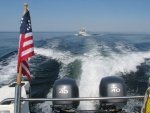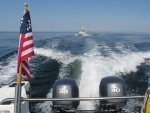Fishhawk
New member
- Joined
- Mar 18, 2007
- Messages
- 245
- Reaction score
- 0
- C Dory Year
- 2006
- C Dory Model
- 22 Cruiser
- Hull Identification Number
- CD022385H506
- Vessel Name
- Osprey
O.K. all,
We had Osprey out on Lake Superior yesterday evening. I ran the tests that I promised and here is what happened:
With one Honda 40 in the water, about a 3 mph tail breeze, flat 52 deg. water, 10-15 gals of fuel, 420 lbs of people, and trolling gear, by no means a heavy load, and if I am to believe my electronics, we achived 16.1 mph at 4600 rpm. WOT.
No B.S.
With both engines WOT we achived 34.5 MPH at 5500 rpm.
So there you have it. My earlier claim of 17-18 mph with one engine was either incorrect or with a lighter load.
If she is an exceptional boat, that's OK with us!!! :lol:
Regards,
Capt Dan
We had Osprey out on Lake Superior yesterday evening. I ran the tests that I promised and here is what happened:
With one Honda 40 in the water, about a 3 mph tail breeze, flat 52 deg. water, 10-15 gals of fuel, 420 lbs of people, and trolling gear, by no means a heavy load, and if I am to believe my electronics, we achived 16.1 mph at 4600 rpm. WOT.
No B.S.
With both engines WOT we achived 34.5 MPH at 5500 rpm.
So there you have it. My earlier claim of 17-18 mph with one engine was either incorrect or with a lighter load.
If she is an exceptional boat, that's OK with us!!! :lol:
Regards,
Capt Dan


